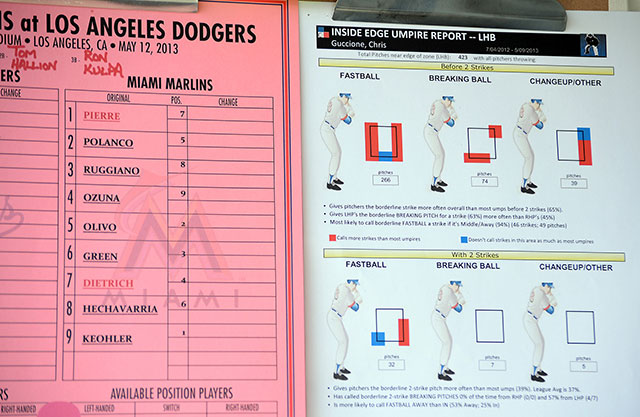Report: MLB mulling shrinking strike zone in ’16
 Official boundaries for the strike zone seem too rigid for human brains. (USATSI)
Official boundaries for the strike zone seem too rigid for human brains. (USATSI)
With runs scored dipping to a 34-year low this past season, Major League Baseball says in 2016 it could change the official rule-book definition of a strike in order to boost offensive production. Independent researchers conclude that umpires, over the past six seasons in particular, have been calling strikes too low — within an area that’s tough for hitters to make solid contact.
Yahoo Sports’ Jeff Passan reports that MLB will spend the 2015 season observing and — if pitching continues to dominate for the suspected reasons — will shrink the zone upward.
The problem, sources said, stems from technological leaps that caused unintended consequences. In 1996, when the league last changed the strike zone to extend it from the top of the knees to the bottom, beneath the hollow of the kneecap, it did so to encourage umpires to call knee-level strikes. The lower end of the zone, in practice, was about three-quarters of the way down the thigh, so the idea was that by adjusting the eye levels of umpires to look lower, the result would be a more traditional strike zone.
Then along came Questec, the computerized pitch-tracking system, followed by Zone Evaluation, the current version tied in to MLB’s PITCHf/x system. With a tremendous degree of accuracy – especially in recent years – the systems tracked textbook balls and strikes, and the home-plate umpires’ performances were graded on a nightly basis. Over time, not only did umpires’ strike zones move down to the knees, they went to the hollow and even a smidge below.
“I don’t think the Playing Rules Committee at the time of the last change ever expected that the umpires would call strikes at the hollow of the knee,” said Mets general manager Sandy Alderson, the current chairman of the committee. “To their credit, the umpires now are.”
Such tinkering, and the additional runs scored that are likely to follow, would seem to counter another of MLB’s wishes — to shorten the length of games, as new commissioner Rob Manfred has stated. A few weeks ago, Manfred sounded gung ho about abolishing acute defensive shifts, but backed off after critics complained. Fine-tuning the strike zone, while something the umpires’ union and the players association would have to agree with, seems like something everyone could get behind. Well all want a “better” strike zone. But there’s reason to believe the problem with the official strike zone is that it exists at all.
Two years ago, Sam Miller of Baseball Prospectus made the case for abolishing the official strike zone and giving the power to the umpires to call balls and strikes as they see them — which is what naturally happens anyway. What Miller really wants — and where MLB probably will go someday — is having computers call balls and strikes. But short of that radical change, here’s what would happen if we harshley abridged the rule book when it comes to the strike zone:
[I]f there was no rulebook, we wouldn’t feel entitled to that pitch. We might not like the umpire’s call, but we would no longer feel victimized by it. It’d be like replacing a judge who is crooked, who is taking bribes, who is passed out drunk, with one who is merely unsympathetic to our case.
Here’s how the rulebook should define a strike:
A ball, delivered by the pitcher while standing wholly within the lines of his position and facing the batsman, that, so delivered, is determined by the umpire to be a fair pitch.
And, instead of a PITCHTRAX graphic in the corner of the screen telling us whether it was on this side of a non-binding border or that side of a non-binding border, would tell us how often a pitch in that location is usually called a strike. A real-world strike zone, like Brooks Baseball provides us, rather than the false and pointless legalistic strike zone that we deploy only when it suits our purposes.
And that should cover it. The pitch must be legal, and it must be in an area in which the hitter has a reasonable expectation of being able to hit it.
Any official boundary for the strike zone always will been too rigid for the human brain to process. The zone, in reality, always has been an umpire’s best guess. So why not be true to what baseball is, and erase the “official” strike zone, when no such zone exists (and can’t exist) in reality? Make determining balls and strikes an entirely human endeavor.
Otherwise, bring in the robots.
Recommended article: Chomsky: We Are All – Fill in the Blank.
This entry passed through the Full-Text RSS service – if this is your content and you’re reading it on someone else’s site, please read the FAQ at fivefilters.org/content-only/faq.php#publishers.